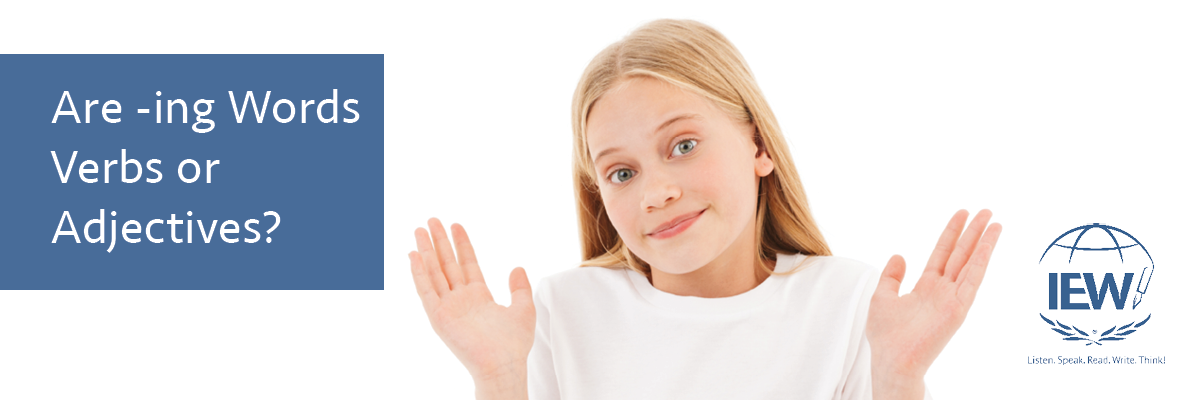
Students commonly struggle to mark -ing words correctly in papers and in Fix It! Grammar. Students who ask the right questions can know with certainty if an -ing word functions as a verb or an adjective.
Present participles are words formed by adding the suffix -ing to the simple present form of a verb. That sounds more complicated than it is. Present participles are simply -ing words: floating, running, croaking.
Present participles function as verbs if they follow a be verb (am, is, are, was, were, be, being, been) and tell what the subject is doing. Both conditions must be met.
Ashley is floating in the water.
Ben and his dog are running.
The frogs were croaking.
In each example, the -ing word follows a be verb. The be verb + -ing word form a verb phrase. In the first example, is floating is the verb. If a student said floating was the verb, the answer would be incomplete. For this reason, words that end in -ing cannot be strong verbs. A student in IEW Online explained it best: “-ing words need help to do a verb’s job. If you need help, you are not strong.”
Following a be verb is the first condition. In each example, the be verb + -ing word tell what the subject is doing.
Ashley is floating
Ben + dog are running
frogs were croaking
If both conditions are not met, then the -ing word cannot function as a verb. Use this flow chart.
- Does the -ing word follow a be verb?
If no, stop because the -ing word is not a verb.
If yes, ask question #2.
- Does the be verb + -ing word tell what the subject is doing?
If no, stop because the -ing word is not a verb.
If yes, the be verb + -ing word work together as a verb.
The running water flowed quickly.
Does running follow a be verb? No! That means running does not function as a verb. In this case, running describes water; running is an adjective. (Water flowed is the subject-verb pair.)
Floating down the river, I dozed in the sun.
Does floating follow a be verb? No! That means floating does not function as a verb. In this case, floating down the river is a participial phrase (an -ing phrase) that describes I. IEW refers to this as the #4 -ing opener. (I dozed is the subject-verb pair.)
I heard the frogs across the lake, croaking an off-key melody.
Does croaking follow a be verb? No! That means croaking does not function as a verb. In this case, croaking an off-key melody is a participial phrase (an -ing phrase) that describes frogs. (I heard is the subject-verb pair.)
The book is interesting.
Does interesting follow a be verb? Yes! Does that make it a verb? No, we must ask the second question.
Does is interesting tell what the book is doing? No! The book is not doing the interesting. In this case, an adjective follows the be verb and describes the subject. What kind of book? interesting book
The frogs are annoying.
Does annoying follow a be verb? Yes! Does that make it a verb? No, we must ask the second question.
Does are annoying tell what the frogs are doing? No! The frogs are not doing the annoying. In this case, an adjective follows the be verb and describes the subject. What kinds of frogs? annoying frogs
The fish were biting.
Does biting follow a be verb? Yes! Does that make it a verb? No, we must ask the second question.
Does were biting tell what the fish were doing? Yes! The fish were doing the biting. The words were + biting work together as the verb phrase in this sentence.
The fish are not biting.
Does biting follow a be verb? Yes! It is common for an adverb to separate a be verb and an -ing word. When you ask the second question, ignore the adverb.
Does are biting tell what the fish are doing? Yes! The fish are doing the biting—or at least someone wishes that they were. The words are + biting work together as the verb phrase in this sentence.
Why does this matter? Andrew Pudewa’s philosophy is to teach grammar at the point of need. It is important that students can distinguish between a verb and an adjective. Students who struggle to label verbs will struggle to find clauses. This results in fragments, run-ons, and poorly punctuated sentences.
Beginning with the first level of Fix It! Grammar, students label verbs. Deciding if an -ing word follows a be verb is not difficult. Determining if the be verb + -ing word tell what the subject is doing requires a higher level of thinking. Be patient with your students and offer encouragement. With continued practice, you’ll train your students’ ears to hear the distinction between words that show action and words that describe.
Asking questions and reasoning together will help your students learn to identify words correctly. As an added bonus, you’ll enhance their reasoning skills. Enjoy the process!
